The Microsoft Surface Laptop 3 (15-Inch) Review: AMD Ryzen Surface Edition
by Brett Howse on October 21, 2019 9:00 AM EST- Posted in
- Laptops
- AMD
- Microsoft
- Surface
- Ryzen
- Surface Laptop
- Surface Laptop 3
Display Analysis
Microsoft continues to be one of the few PC manufacturers that calibrates all of their device displays, from the lowly Surface Go, all the way to the ultra-expensive Surface Studio range. They’ve also fully embraced the 3:2 aspect ratio for all devices, which initially made their convertible designs better at being convertible, but also makes for a better experience on the Surface Laptop. The Surface Laptop 3 features a 3:2 2496x1664 display, offering a 200 pxiels-per-inch density. With regards to calibration, Microsoft includes a sRGB calibration, as well as the “Enhanced” profile that was first introduced on the Surface Pro a few years ago, which doesn’t stick to sRGB exactly, but provides a bit richer color tones without affecting skin tones.
Microsoft also offers touch and pen support on the Surface Laptop 3. The touch works great, and pen support is also a nice option, although less useful than on something like the Surface Pro where you can use the display as a notebook. The Surface Laptop display only opens about 135°.
To see how the Surface Laptop 3 performs, it was tested with Portrait Display’s CalMAN software suite, along with an X-Rite i1Display Pro colorimeter for brightness and contrast testing, and an X-Rite i1Pro2 spectrophotometer for color accuracy assestment.
Brightness and Contrast
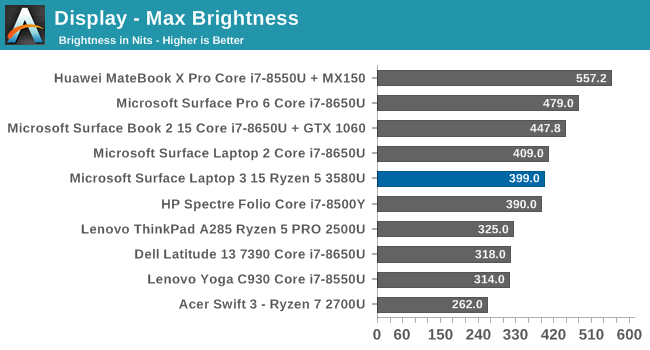
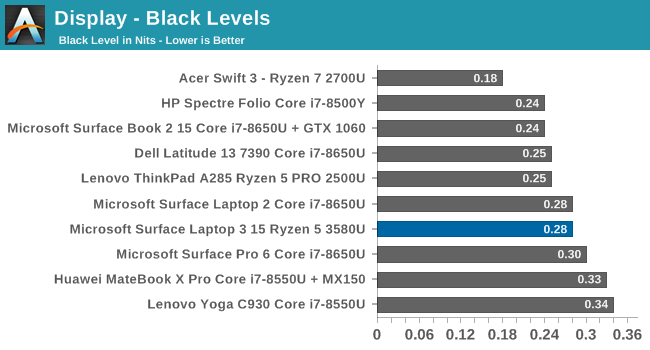
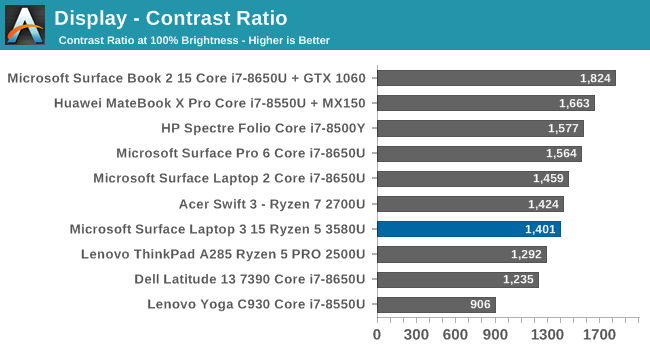
The Surface Laptop 3 gets reasonably bright, with up to about 400 nits of maximum brightness, but still offers great black levels, resulting in a solid 1400:1 contrast ratio. While not quite the contrast of a Surface Book, it’s still a great result. For those that are interested, the display will go all the way down to 4 nits at minimum brightness, so there’s a pretty wide range here.
Grayscale
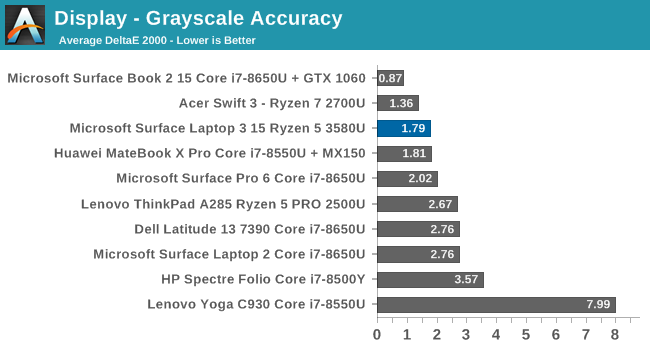
When evaluating grayscale, we’re looking for values under the 3.0 level to be basically imperceptible to the human eye, and the Surface Laptop 3 easily achieves that. At no point during the sweep did any of the gray levels exceed the 3.0 level, which is excellent. The gamma came in close to the 2.2 target as well.
Gamut
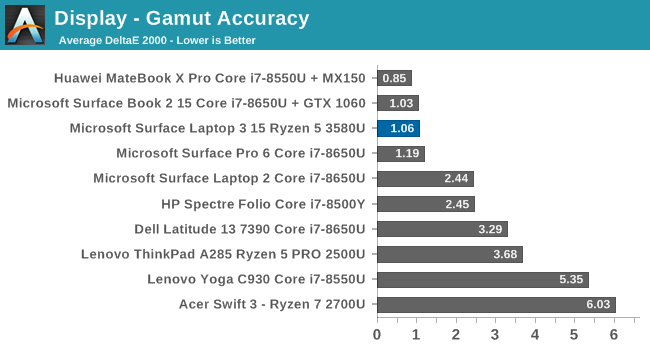
The gamut test highlights the primary and secondary colors at 100% brightness, and the Surface Laptop 3 performs very well here, with all of the colors coming in under an error level of 1.0 and providing full sRGB coverage.
Saturation
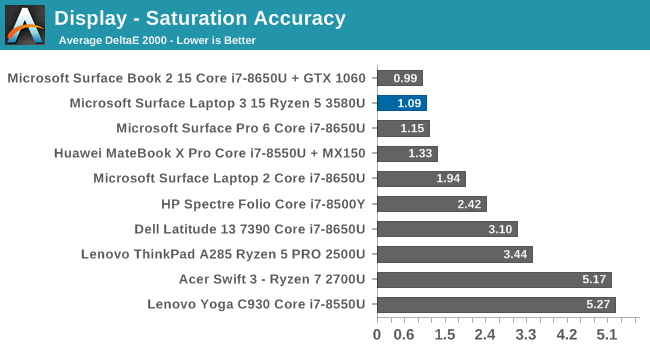
The saturation test is identical to the gamut test, but rather than testing at just 100% levels, the primary and secondary colors are tested in 4-bit steps from 0% all the way to 100%. The Surface Laptop 3 is almost perfect across the entire range, with yellow only being slightly over the 3.0 threshold for the first couple of steps.
Gretag Macbeth
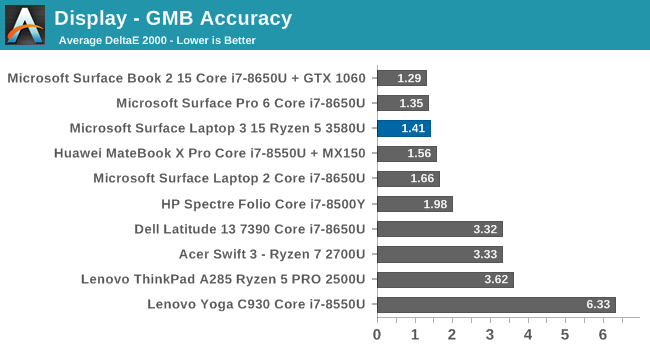
The Gretag Macbeth test expands the tested to color to those well off the primary and secondary color axis, and the Surface Laptop 3 is nearly perfect, with none of the tested colors coming in over the 3.0 limit of perception on the DeltaE 2000.
Display Conclusion
Microsoft continues to set a high bar in terms of displays. The Surface Laptop 3 doesn’t quite offer the resolution of the Surface Book series, but the IGZO display is finely tuned, offering near-perfect color calibration out of the box. Add in both touch and pen support, coupled with the excellent 3:2 aspect ratio, and the result is a delightful display, continuing the Surface tradition. It would be nice to see the Surface team move more towards wider gamut displays, and HDR as well, but until Windows solves its color management issues, that may not be as good of a solution as a properly done sRGB panel.


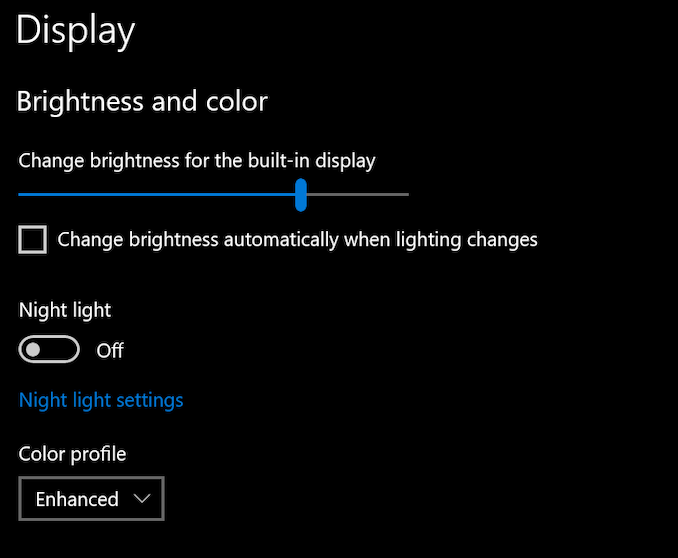












91 Comments
View All Comments
evernessince - Tuesday, October 22, 2019 - link
You make it sound like last gen Intel mobile products are such a step back when in fact they are identical to current products on the market and Intel's "next-gen" products as well. The performance gains have piddling at best. 8 and 9th gen products for all intents are purposes are the same architecture and nm process. You also left out the fact that an R5 mid range processor is beating some of Intel's i7 high end processors in CPU performance. Battery life could be better but have you done the calculation of performance per mAH of the battery? Or are you just assuming with considering the size of the battery and the performance being afforded? How do Intel laptops with similar performance characteristics and battery size fare? Like any laptop, battery life is dependent on more then just the chip on the device.Your comment is misleading, intentional or otherwise.
0ldman79 - Sunday, December 15, 2019 - link
Nah, AMD's battery life still isn't up to par against Intel's 25th Skylake revision, not even the original release.AMD is kicking ass on the desktop but the mobile front is still a bit much. Intel has spent billions making laptops more efficient. They've done well. They got the laptop market under their thumb, even today, while they've effectively lost the performance desktop battle.
The_Assimilator - Monday, October 21, 2019 - link
Not sure why AMD had such a hard-on to get a CPU that is evidently not mobile-focused, into an extremely mobile form factor. No support for LPDDR4, no built-in WiFi, and an iGPU that isn't powerful enough to make any tangible difference to an Intel offering, just makes for a "why".Irata - Monday, October 21, 2019 - link
Oh, Ryzen's iGPU does offer a tangible real life difference if the reviewer choses to include the right benchmarks and also show's the Intel iGPU results for them.Tech Report's and Computer Base's Ryzen 2500u review do and they show that the tangible difference is 50 to over 100% better fps, greatly better frame times, i.e. the difference between a game being playable, or not.
TheinsanegamerN - Tuesday, October 22, 2019 - link
If you have to include “the right benchmarks” to make your APU look good, your product sucks, and you are engaging in the very behavior you accuse anandtech of. Hypocritical.evernessince - Tuesday, October 22, 2019 - link
Well that depends. The sample size is this review is rather small. Very small in fact. Adding more certainly wouldn't hurt. It's less about adding the right benchmarks then it is getting a more reliable dataset. If another review is showing data that more appropriately demonstrates the GPU's capability, that indicates that perhaps the test suite used here is not ideal.Irata - Thursday, October 24, 2019 - link
With "the right" I mean proper benchmarks.One of the advantages of having a better iGPU is that it allows you to do things that you cannot do with a weaker iGPU. Casual gaming, particularly e-sports titles come to mind. Same for any GPU accelerated software.
If you do not include any of those in a review (e.g. just compare them on the basis of surfing the web and watching a few videos), then you are hiding these advantages.
MS segmented their surface laptops into "business" (Intel) where the better battery life is an advantage when you are using it for email, powerpoint, Word, Excel but most likely not causal gaming or content creation.
For this you have have the AMD based consumer platform with its faster iGPU - have a look at the PC mark scores to see how it scores there. You can also check other reviews for Laptops with other Ryzen APU to see that they do offer a tangible advantage over Intel's iGPU when it comes to being able to still play a game or not.
That advantage is paid for with lower battery life in idle / low load situations (not necessarily true for higher load), so it really comes down to what is more important to you. I know that for my work laptop, I would value the extra battery life, for a personal one the ability to do a bit of casual gaming would be worth having a shorter battery life (which is still decent, we are not talking Bulldozer here).
So not hypocritical imho. Just pointing out that a review should include tests for what it was built for / is aimed at.
m53 - Wednesday, November 20, 2019 - link
All the benchmarks I have seen so far, the ice lake iGPU is equal or better than AMD APUs for same TDP. On the otehr hand the CPU is tangibly faster with much better battery life and connectivity (wifi6 built-in).Fulljack - Tuesday, October 22, 2019 - link
Intel doesn't have built-in wifi either. current offering actually still use smaller RF module, due to Intel CNVi. I don't get why Microsoft doesn't release AMD with latest ax chipset, because Intel AX200 does works on AMD system too.GreenReaper - Tuesday, October 22, 2019 - link
Surely it's because it costs more, and this is meant to be the more affordable option?